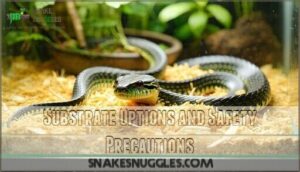This site is supported by our readers. We may earn a commission, at no cost to you, if you purchase through links.

Start with a proper terrarium setup that includes correct heating, lighting, and humidity levels.
Your snake’s environment should mimic its natural habitat with appropriate hiding spots and substrate.
Feed your snake pre-killed prey on a regular schedule, and resist the urge to handle them right after meals.
Watch for signs of illness like lethargy, loss of appetite, or unusual behavior patterns.
Regular vet checkups keep your scaly friend healthy.
Creating a stress-free environment is half the battle, and there’s more to keeping your snake thriving than you might expect, including providing the right conditions for your snake to live a long and healthy life, and ensuring you provide the best possible care for your scaly friend.
Table Of Contents
- Key Takeaways
- Choosing The Right Snake
- Setting Up Your Snake’s Home
- Essential Snake Supplies
- Creating a Safe and Healthy Environment
- Feeding Your Snake
- Snake Health and Safety
- Handling and Interacting With Your Snake
- Maintaining a Clean and Hygienic Terrarium
- Advanced Snake Care and Considerations
- Preparing for Potential Challenges
- Frequently Asked Questions (FAQs)
- How to take care of a snake for beginners?
- How often do snakes need to go to the vet?
- How do I keep my snake healthy?
- Should you hold your snake every day?
- How to choose pet snakes for beginners?
- How do you keep a pet snake healthy?
- What snakes are good for beginners?
- How do you handle a snake safely?
- How to care for a snake for beginners?
- How do I make sure my snake is healthy?
- Conclusion
Key Takeaways
- Start with beginner-friendly species – You’ll want to choose calm, manageable snakes like ball pythons or corn snakes that handle easily and forgive mistakes better than more aggressive species.
- Create proper temperature zones – You’ll need to maintain a temperature gradient with basking spots at 85-92°F and cooler areas at 75-80°F, using heating elements and thermostats to prevent overheating.
- Establish consistent feeding and cleaning routines – You’ll feed juveniles every 5-7 days and adults every 10-14 days with frozen prey, while maintaining weekly enclosure cleaning to prevent disease.
- Watch for health warning signs – You’ll need to monitor for stress indicators, like excessive hiding, respiratory issues, like open-mouth breathing, and behavioral changes that signal it’s time for veterinary care.
Choosing The Right Snake
Choosing your first snake doesn’t have to feel overwhelming—it’s actually one of the most exciting parts of becoming a snake owner.
Start with beginner-friendly species like ball pythons or corn snakes, which are known for their calm temperaments and manageable care requirements.
Popular Snake Species for Beginners
Starting your snake journey? Ball pythons and corn snakes are perfect for snake beginners.
These docile species rarely bite and handle easily. Spotted pythons stay compact at 3 feet, while kingsnakes and milk snakes offer striking patterns.
All five species thrive with basic snake care for beginners – making your first snake health care experience stress-free and rewarding.
Factors to Consider When Selecting a Snake
After exploring popular snake species, you’ll need to match one with your situation. Size Considerations matter most – a ball python needs different space than a corn snake.
Consider these factors for successful snake care for beginners:
- Adult size: Will your snake outgrow your available space?
- Temperament Traits: Does the species handle stress well during interactions?
- Feeding requirements: Can you provide frozen mice or do you need live prey?
- Lifestyle Compatibility: Does your schedule allow proper temperature monitoring?
Beginner snake owners should prioritize Beginner Friendliness over exotic appeal. Snake temperament affects daily care – docile species like corn snakes forgive mistakes better than defensive ones.
Always practice Venomous Avoidance by choosing non-venomous snake species. Your first snake should fit your experience level, not your wishlist.
Researching Snake Behavior and Temperament
Understanding your snake’s personality is like getting to know a new roommate – you’ll want to observe their daily habits first.
Species Differences reveal that corn snakes are naturally curious explorers, while ball pythons prefer quiet corners.
Watch for Behavioral Cues like defensive posturing or relaxed movements during snake handling sessions.
Docility Factors and Environmental Enrichment needs vary dramatically between species, directly affecting Handling Impact and your snake’s comfort level.
Avoiding Venomous Snakes for Beginners
When choosing your first snake, steer clear of venomous species. Venomous snakes pose serious risks and require expert-level experience. Instead, focus on safe alternatives like ball pythons or corn snakes.
These beginner-friendly options offer the same fascination without the danger.
Here’s why avoiding venomous snakes matters:
- Venomous Identification – Distinguishing venomous from non-venomous species requires years of training and can be life-threatening if wrong
- Legal Repercussions – Many states prohibit venomous snake ownership, with violations carrying hefty fines and criminal charges
- Beginner Dangers – Snake bites from venomous species can cause permanent injury or death, even with proper medical treatment
- Expert Consultation – Professional snake handling takes decades to master, making venomous species unsuitable for new owners
Remember: there’s no shame in starting with safe alternatives. Non-venomous snakes provide identical learning experiences without putting your family at risk.
Snake safety should always come first – you can’t enjoy your pet if you’re in the hospital! Focus on snake beginner tips that prioritize your wellbeing while building confidence with harmless species.
Setting Up Your Snake’s Home
Creating your snake’s home is like setting up a cozy apartment that meets all their specific needs.
You’ll need to take into account the right size terrarium, safe substrate, proper heating, and enrichment items that make your snake feel secure and comfortable.
The goal is to create an environment where your snake can thrive, with a secure space to live and grow.
Terrarium Size and Layout Considerations
Your snake’s new home needs careful planning to keep them happy and healthy. Think of it like designing a cozy apartment with different rooms and climate zones.
Create a cozy snake sanctuary that feels like home, not a sterile box.
- Enclosure Dimensions: Size the terrarium to 2/3 your snake’s expected adult length for adequate space.
- Spatial Enrichment: Add branches, logs, and hiding spots to create natural exploration opportunities.
- Thermal Gradient: Design temperature zones from warm basking areas to cooler retreat spaces.
- Hiding Strategies: Include visual barriers like plants or rocks to help your snake feel secure.
Substrate Options and Safety Precautions
Your snake substrate is their bedroom floor – it needs to be comfortable and safe.
Aspen shavings work well for most species, offering good humidity control without substrate toxicity risks.
Cypress mulch is another solid choice.
Avoid cedar or pine shavings, which can cause respiratory problems and allergen concerns.
Paper towels work temporarily but don’t provide natural behavior opportunities.
Watch for impaction risks with loose substrates – size matters here.
Your terrarium setup should include substrate that’s easy to spot-clean and replace.
Many keepers purchase quality aspen bedding for their enclosures.
Most snake substrate needs changing every 2-4 weeks, depending on your enclosure maintenance routine and disinfection methods used.
Providing Enrichment and Hiding Places
Once you’ve selected the right substrate, your snake habitat needs strategic snake enrichment to create a comfortable, engaging environment. Think of it like decorating your home – you want function and comfort rolled into one.
**Hiding spots are your snake’s security blanket.
Choose hiding places that match your snake’s body size – not too tight, not too roomy.
** A good rule of thumb: your snake should touch three sides when coiled inside.
**Mental stimulation keeps your snake’s mind sharp.
Rotate decorations monthly to prevent boredom.
** It’s like rearranging furniture – familiar yet fresh.
Here’s your enrichment checklist:
- Visual barriers like plants or rocks help nervous snakes feel secure
- Climbing structures provide exercise opportunities for arboreal species
- Burrowing substrates satisfy natural digging instincts
- Enrichment variety through different textures and materials
- Hiding size options – multiple spots throughout the snake enclosure
Your snake enclosure should feel like a mini ecosystem, not a sterile box.
Heating and Lighting Requirements for Snakes
Perfect baking spot temperatures range from 85-90°F, while cooler areas stay around 75-80°F.
This temperature gradient lets your snake thermoregulate naturally.
Heat sources like ceramic emitters work better than UVB lighting for most species.
Light cycles aren’t critical, but maintaining consistent snake temperature is essential for snake health.
Use thermostats to prevent overheating—your snake’s life depends on proper heating and lighting for ideal snake care.
Essential Snake Supplies
You’ll need several key supplies to create a comfortable home for your snake before bringing it home.
Getting the right equipment from the start helps prevent stress and health problems that can cost you time and money later, which is crucial for a healthy and comfortable environment.
Housing and Decorations for Snakes
Your snake’s home needs more than just four walls – it’s their entire world! Think of yourself as an interior designer for a very particular client who values security above all else.
Enclosure Security starts with a tight-fitting lid that won’t budge when your curious snake decides to explore.
Here’s what makes a perfect snake sanctuary:
- Secure latches that prevent Houdini-style escapes
- Multiple hiding spots using caves, logs, or commercial hides
- Climbing branches for species that enjoy vertical space
- Visual barriers like plants to reduce stress
- Easy-clean surfaces that simplify maintenance
Choose decorations that won’t tip over or create sharp edges.
Your snake’s habitat needs include feeling safe while you maintain proper temperature control zones.
Quality snake care means balancing enrichment ideas with safety – no loose substrates near heat sources or decorations that could fall.
Heating and Lighting Equipment for Terrariums
Your terrarium’s heating and lighting system is like your snake’s personal climate control.
Getting the right equipment keeps your scaly friend comfortable and healthy year-round.
- Heat bulbs and ceramic heaters create essential basking spots while maintaining proper temperature gradients
- Thermostat control prevents dangerous overheating and maintains consistent temperatures for ideal snake health
- UVB importance can’t be overstated—proper lighting spectrum supports calcium metabolism and prevents metabolic bone disease
Selecting the right snake heat source is vital for their well-being.
Food and Water Dishes for Snakes
Your snake needs the right bowls to stay healthy and happy. Choose heavy ceramic or glass dishes that won’t tip over when your snake moves around.
For water, pick a bowl deep enough for soaking but shallow enough to prevent drowning. Separate dishes for food and water prevent contamination and make cleaning easier.
Consider using durable feeding options for reptile care. Replace water every few days and wash dishes weekly with reptile-safe cleaners.
Position bowls away from heating elements to maintain proper water quality and prevent rapid evaporation during snake care routines.
Hiding Places and Enrichment Items for Snakes
The secret to happy snake health lies in creating a home that feels natural and secure.
Your reptile needs hiding spots and enrichment items to thrive in their snake enclosure. Here’s how to make it happen:
- Natural hides: Use rocks, logs, and commercial caves to create secure hiding spots where your snake can feel safe and reduce stress.
- Climbing branches: Add sturdy branches for arboreal species or ground-dwelling snakes that enjoy occasional climbing adventures.
- Visual barriers: Place plants or decorations to block sight lines, giving your snake privacy and reducing anxiety in their reptile care setup.
- Substrate enrichment: Rotate different textures and depths to encourage natural burrowing behaviors and mental stimulation.
Remember, hides importance can’t be overstated—every snake needs at least two hiding places. Regular enrichment rotation keeps things interesting for your scaly friend.
Creating a Safe and Healthy Environment
Your snake’s environment directly impacts its health and happiness, making proper setup essential for beginners.
Getting the temperature, humidity, and cleanliness right from day one prevents most common health problems and creates a stress-free home where your new pet can thrive.
Temperature and Lighting Guidelines for Snakes
The secret to happy snakes lies in getting their heating and lighting just right.
Think of it like creating a cozy neighborhood where your snake can pick their perfect spot.
You’ll need to establish a proper heat gradient with a warm basking spot on one end and cooler areas for lounging.
Here’s your temperature roadmap:
| Snake Type | Basking Spot | Cool Side | Night Temperatures | UVB Lighting |
|---|---|---|---|---|
| Ball Python | 88-92°F | 78-80°F | 75-78°F | Optional |
| Corn Snake | 85-88°F | 75-78°F | 70-75°F | Beneficial |
| King Snake | 85-90°F | 75-80°F | 70-75°F | Recommended |
| Boa Constrictor | 88-92°F | 78-82°F | 75-78°F | Optional |
| Milk Snake | 80-85°F | 70-75°F | 65-70°F | Beneficial |
Use under-tank heaters or ceramic heat emitters to maintain this temperature gradient.
While snake lighting isn’t always essential, UVB lighting supports better snake health care.
Remember, seasonal changes affect your pet’s needs—they’re naturally wired to notice these shifts!
Humidity and Ventilation Considerations for Terrariums
Getting humidity balance right keeps your snake healthy and happy.
Most species need 40-60% humidity levels, monitored with a hygrometer for accuracy.
Ventilation methods like screened lids prevent stagnant air while maintaining proper humidity levels.
Good airflow supports respiratory health and shedding success while preventing mold prevention issues.
Humidity monitoring guarantees your snake’s comfort and prevents health problems.
Disinfection and Cleaning Schedule for Snake Enclosures
A clean snake enclosure prevents illness and keeps your pet happy. You’ll need a weekly cleaning schedule to stay ahead of problems.
Weekly Cleaning Frequency keeps bacteria at bay:
- Choose reptile-safe disinfectants like F10 or diluted bleach for thorough snake disinfection
- Remove waste daily from your snake enclosure to prevent bacterial growth
- Clean water bowls twice weekly with hot water and scrub away biofilm buildup
- Replace substrate monthly while spot-cleaning soiled areas to maintain proper snake cleaning standards
This snake cleaning routine prevents mites and disease.
Avoiding Hazards and Safety Risks in Snake Care
Several key hazards threaten your snake’s well-being, but smart preparation keeps everyone safe. Enclosure Security ranks as your top priority—loose snakes face deadly household dangers like ceiling fans, electrical cords, and hiding spots you’ll never find. Check latches weekly and consider adding clips for extra protection.
A loose snake in your house is like finding a needle in a haystack—except the needle can hide anywhere and you need to find it fast.
Handling Bites happens to most owners eventually. Stay calm, don’t pull away quickly, and let your snake release naturally. Keep antiseptic handy and watch for infection signs.
Salmonella Prevention requires washing hands thoroughly after every interaction. Your snake carries bacteria that won’t harm them but can make you sick.
Prey Safety means using frozen-thawed rodents instead of live ones. Live prey can injure your snake during feeding struggles, causing serious wounds.
Venomous Risks don’t apply to beginner species, but always verify what you’re buying. Even experienced handlers avoid venomous snakes.
Watch for snake stress signals like refusing food, excessive hiding, or aggressive behavior—stressed snakes are more likely to bite and develop health problems.
Feeding Your Snake
Proper nutrition forms the foundation of snake health, making feeding decisions essential for your pet’s wellbeing.
You’ll need to understand your snake’s specific dietary requirements, establish consistent feeding routines, and master safe handling techniques to keep both you and your snake healthy.
Choosing The Right Food for Your Snake Species
Your snake’s dietary success hinges on understanding species-specific feeding requirements.
Most pet snakes thrive on rodents, but prey size and nutritional variety matter tremendously.
Frozen options offer safety advantages over live prey, while some species need supplements.
- Prey Size: Match food width to your snake’s thickest body section
- Frozen vs Live: Pre-killed prey reduces injury risks and stress
- Nutritional Variety: Rotate between mice, rats, and appropriate alternatives
- Supplement Needs: Captive snakes may require calcium or vitamin additions
- Species Requirements: Research your snake’s natural diet preferences
Feeding Schedule and Frequency for Snakes
You’ve picked the perfect food – now let’s talk timing. Think of feeding schedules like your snake’s personal meal planner. Getting the feeding frequency right keeps your scaly friend healthy and happy without overloading their system.
Age determines everything regarding snake feeding schedules. Hatchlings are like teenagers – they need frequent meals every 5-7 days to fuel their rapid growth. Juveniles slow down a bit, requiring food every 7-10 days. Adult snakes? They’re the easy-going ones, content with meals every 10-14 days.
Ethical sourcing of prey is important for a snake’s well-being, so consider reputable prey suppliers.
Snake Age Feeding Frequency Prey Size
Remember, these feeding requirements aren’t set in stone. Your snake’s individual needs matter most.
Handling and Feeding Techniques for Snakes
Since safe handling starts with the right tools, grab feeding tongs and a snake hook before approaching your pet.
These tools prevent accidental bites while maintaining proper prey size during feeding.
Watch for recognizing hunger signs like increased activity, then use gentle handling techniques to guide your snake.
Master these snake feeding basics, and you’ll handle feeding refusals like a pro.
Remember: confident movements keep both you and your snake comfortable during feeding frequency routines.
Monitoring Food Intake and Weight in Snakes
After verifying proper feeding techniques, tracking your snake’s food intake and weight prevents health issues that could cost you big time later.
Think of it as keeping a food diary for your scaly friend – you’ll spot problems before they become serious.
Proper prey size should match your snake’s thickest body part, while feeding frequency depends on age and species.
Digital scales help you monitor changes that might signal trouble ahead.
Here are four key monitoring strategies:
- Weekly weigh-ins: Use digital scales to track gradual weight changes that indicate snake health trends.
- Food logs: Record prey size, feeding frequency, and your snake’s response to meals.
- Growth charts: Document weight patterns to identify normal snake growth versus concerning changes.
- Warning signs: Watch for visible ribs (underfeeding) or reluctance to move (overfeeding) that signal snake nutrition problems.
Regular monitoring catches snake feeding refusals early and guarantees proper snake care throughout your pet’s life.
Snake Health and Safety
Keeping your snake healthy isn’t rocket science, but it does require you to become a bit of a detective.
You’ll need to watch for subtle changes in behavior, appetite, and appearance that could signal trouble before it becomes serious.
Recognizing Signs of Stress and Disease in Snakes
The signs your snake isn’t feeling well are like warning bells you can’t ignore.
Stress indicators include restlessness, excessive hiding, or defensive striking. Watch for respiratory issues like open-mouth breathing or nasal discharge.
Skin problems, abnormal behavior, and weight changes signal trouble. Common snake health issues range from parasites to infections, making early detection essential for snake health concerns.
If your snake isn’t eating, it may be time to check for underlying health problems.
Annual Veterinary Check-Ups and Care for Snakes
Your snake’s annual wellness exams aren’t just checkups—they’re your pet’s health insurance policy.
A qualified reptile vet can spot respiratory issues and other snake health problems before they become serious. Think of preventative care like tuning up your car; it keeps everything running smoothly and saves you money long-term.
- Wellness exams include weight checks, body condition scoring, and parasite prevention screenings
- Dental health assessments help identify mouth rot and feeding problems early
- Veterinary care records track your snake’s health patterns and vaccination history
Common Health Issues and Treatments in Snakes
Your snake’s health depends on spotting problems early. Watch for these common issues that can turn serious fast.
| Health Issue | Key Signs | Treatment | Prevention |
|---|---|---|---|
| Respiratory Infections | Wheezing, open-mouth breathing, nasal discharge | Antibiotics, temperature correction | Proper humidity, clean habitat |
| Scale Rot | Blisters, ulcers on belly scales | Topical antibiotics, dry substrate | Avoid wet bedding, regular cleaning |
| Mites and Ticks | Tiny moving dots, skin irritation | Anti-parasitic medications, enclosure disinfection | Quarantine new animals, clean supplies |
| Mouth Rot | Swollen gums, pus, foul smell | Aggressive antibiotic therapy, deep cleaning | Stress reduction, proper cage hygiene |
Parasite control starts with good snake vet care. Owners should be aware that respiratory issues are reported in snakes.
Most snake diseases catch owners off-guard, but regular monitoring prevents small problems from becoming expensive emergencies. Snake shedding problems often signal underlying health issues, so don’t ignore incomplete sheds.
Emergency Care and First Aid for Snakes
When your snake faces a crisis, quick action saves lives.
Snake health emergencies require immediate attention and proper snake first aid techniques to prevent serious complications.
- Snake bites: Clean wounds gently, apply pressure to stop bleeding, and contact snake vets immediately
- Respiratory distress: Move your snake to suitable temperature zones and make certain proper humidity levels
- Thermal burns: Remove heat sources, cool affected areas with room-temperature water, seek snake vet care
- Prolapsed tissue or scale rot: Don’t attempt home treatment—these conditions need professional snake care
Handling and Interacting With Your Snake
Building a relationship with your snake takes patience and understanding its unique body language.
You’ll need to learn proper handling techniques and recognize when your snake wants to be left alone, especially after meals when it’s focused on digestion.
Handling Techniques and Safety Precautions for Snakes
Proper Safe Handling starts with calm, deliberate movements. Always wash your hands before and after contact—good Hygiene Practices prevent bacterial transfer.
Support your snake’s body completely, never grabbing just the head or tail. Watch for warning signs like hissing or coiling, which signal stress.
Bite Prevention means respecting your snake’s boundaries and never handling when it’s hungry or shedding.
| Do This | Avoid This | Why It Matters |
|---|---|---|
| Support entire body | Grab head/tail only | Prevents injury and stress |
| Move slowly and calmly | Quick, jerky motions | Reduces defensive responses |
| Wash hands thoroughly | Skip hand hygiene | Prevents disease transmission |
| Read body language | Ignore warning signs | Avoids bites and trauma |
| Use handling techniques confidently | Handle when nervous | Snake senses your anxiety |
Building Trust and Confidence With Your Snake
Now that you’ve mastered safe handling techniques, it’s time to build a genuine bond with your snake. Think of this like making a new friend – patience wins the day.
Your snake needs time to recognize you’re not a threat, and consistent interaction helps create that trust. Start with brief, gentle handling sessions and watch for relaxed body language. Your snake will learn your scent and touch over time.
Predictable routines work wonders – snakes appreciate knowing what to expect. Here are three snake handling tips for building confidence:
- Use positive reinforcement – reward calm behavior with consistent, gentle handling sessions
- Maintain predictable routines – handle your snake at the same times to reduce stress
- Practice reading signals – watch for relaxed posture versus defensive coiling during consistent interaction
Recognizing Body Language and Behavior in Snakes
Once you’ve built trust with your snake, you’ll notice their body language tells a story.
Watch for defensive postures like S-shaped coiling when they feel threatened.
Stress signals include rapid tongue flicking, hissing, or tail rattling.
Relaxed snakes show loose, flowing movements.
| Body Language | What It Means | Your Response |
|---|---|---|
| Tight coiling | Feeling threatened | Give space, move slowly |
| Loose, open posture | Relaxed and comfortable | Safe to approach |
| Rapid tongue flicking | Stressed or overstimulated | Reduce handling time |
| Hissing or striking pose | Defensive mode | Stop handling immediately |
| Slow, deliberate movement | Curious exploration | Perfect handling opportunity |
Shedding behavior brings temporary grumpiness, while hunting behaviors make them more active.
Understanding these behavioral signs of stress helps you become a better snake parent.
Avoiding Handling After Feeding Snakes
Once you’ve mastered your snake’s behavior, it’s time to talk about post-meal care. After feeding, your snake enters a vulnerable state where digestion discomfort can easily occur. Regurgitation risk peaks during this sensitive period, making stress reduction your top priority.
Wait 48-72 hours before any interaction to confirm safe handling. Your snake needs this time for proper post-meal care without interference.
Here’s what smart snake owners do:
- Give your snake complete privacy to digest peacefully
- Resist the urge to check on them constantly
- Keep the enclosure undisturbed and quiet
- Maintain consistent temperatures for ideal digestion
- Watch for signs of distress from a respectful distance
Following these snake care tips for beginners prevents serious health issues and builds trust with your pet.
Maintaining a Clean and Hygienic Terrarium
A clean terrarium isn’t just about looks—it’s your snake’s first line of defense against illness and stress.
You’ll need to master daily spot cleaning and weekly deep cleans to keep your scaly friend healthy and happy, which involves complete concepts like understanding the importance of cleaning in maintaining your pet’s well-being.
Cleaning Schedule and Disinfection Methods for Snake Enclosures
Keeping your snake’s home spotless isn’t just about appearances—it’s about preventing disease and keeping your scaly friend healthy.
A solid cleaning schedule forms the backbone of good snake care, and it’s easier than you might think.
Cleaning Frequency matters more than perfection.
Start with daily tasks like renewing water bowls and removing obvious waste.
Weekly deep-cleaning sessions keep bacteria at bay, while monthly substrate replacement prevents buildup of harmful microorganisms.
Disinfectant Options should be reptile-safe—never use household cleaners that contain ammonia or bleach.
Look for products specifically designed for reptile enclosures, or create a simple solution with diluted white vinegar.
Water Bowl Hygiene requires daily attention since snakes often soak and defecate in their water.
Preventative Measures include spot-cleaning immediately when you notice waste, which stops bacterial growth before it starts.
Here’s your snake cleaning guide:
Task Frequency Tips
Substrate Replacement
This snake cleaning schedule becomes second nature with practice, turning your snake enclosure into a healthy haven.
Removing Waste and Uneaten Food From Terrariums
Looking at waste and uneaten food removal from your snake’s terrarium, daily spot cleaning keeps your pet healthy and your home odor-free.
Proper waste identification and cleaning frequency prevent bacterial growth that threatens snake health.
Here’s your essential cleaning routine:
- Remove solid waste immediately – Use dedicated tongs to prevent contamination and protect your hands
- Discard uneaten prey within 24 hours – Rotting food creates dangerous bacteria that can sicken your snake
- Clean water bowls weekly – Fresh water prevents dehydration and supports proper shedding
- Spot-clean soiled substrate – Target wet or dirty areas to maintain hygiene without full substrate replacement
Tool selection matters for effective hygiene practices.
Keep separate cleaning supplies for your snake enclosure to avoid cross-contamination.
Regular waste removal protects substrate impact and extends its lifespan, saving you money while maintaining your snake’s health.
Replacing Substrate and Decorations in Snake Enclosures
Your snake’s home gets a fresh makeover every few months!
Replace soiled substrate like aspen shavings or cypress mulch when it’s dirty or smells funky.
Clean decorations with reptile-safe disinfectant, rotating enrichment items to prevent boredom.
Choose safe materials like natural wood or PVC pipes, avoiding cedar or pine that can harm your scaly friend’s respiratory system.
Monitoring Temperature and Humidity Levels in Terrariums
A digital thermometer becomes your best friend for tracking Ideal Temperature gradients. Your snake’s health depends on proper Humidity Monitoring through hygrometer placement in both warm and cool zones.
Gradient Importance can’t be overstated—snakes need choices! Seasonal Adjustments matter too, as winter heating changes humidity levels.
Essential monitoring tools for superior snake health:
- Place hygrometers at different terrarium heights for accurate readings
- Check temperature gradients daily using infrared thermometers
- Maintain species-specific humidity ranges (30-60% for most snakes)
- Adjust heating elements based on seasonal room temperature changes
Advanced Snake Care and Considerations
When you master the basics, you’ll face new challenges like helping your snake shed, preparing for brumation, and keeping them curious.
Even the best-kept snakes will shed skin (and attitudes), so get ready for a few surprises and a lot of learning.
Brumation and Hibernation Care for Snakes
Understanding snake brumation helps you provide better care during this natural dormancy period.
Most snakes brumate between September and April, entering a state where they remain awake but extremely lethargic.
Unlike true hibernation, your snake might occasionally wake to drink water before returning to rest.
Here’s what you need to know about brumation triggers and care:
- Temperature cycling from 40-50°F gradually signals brumation time
- Hydration importance continues—always provide fresh water access
- Stop feeding 10-14 days before cooling to clear digestive tract
- Monitor weight and responsiveness during the dormant period
- Post-brumation feeding starts slowly with easily digestible meals
During this time, monitoring for signs of excessive weight loss is key.
Create a quiet, dark space that mimics natural conditions for successful snake brumation and hibernation.
Shedding and Skin Care for Snakes
Something magical happens when your snake outgrows its skin – it’s shedding time! Shedding frequency depends on age and growth rate, typically every 4-6 weeks for juveniles.
Watch for milky eyes and dull coloring as signs. Maintain proper humidity (50-60%) to prevent stuck shed, which can cause skin infections.
Check for retained pieces around eyes, tail, and belly after each shed. Provide rough surfaces like branches to help the process.
If stuck shed occurs, increase humidity and offer a humid hide. Never pull shed skin manually – this risks injury. Proper snake care during shedding keeps your pet healthy and comfortable.
Providing Mental Stimulation and Enrichment for Snakes
Why settle for a boring snake when you can create an exciting world? Your snake craves mental stimulation just like you need variety in your day.
Smart enclosure complexity keeps your pet engaged and healthy.
Here’s how to boost snake mental stimulation:
- Add novel objects: Rotate branches, rocks, and hiding spots weekly to spark curiosity and exploration behavior.
- Create foraging opportunities: Use puzzle feeders that challenge your snake’s natural hunting instincts and problem-solving skills.
- Enhance sensory enrichment: Include different textures, scents, and climbing surfaces to stimulate all their senses naturally.
Environmental enrichment prevents boredom and promotes snake activity through engaging, ever-changing surroundings.
Planning for Long-Term Snake Care and Commitment
Lifespan commitment means 20-30 years with your snake—that’s a marathon, not a sprint.
You’ll face financial burden from vet bills, food, and equipment upgrades. Plan for emergency planning scenarios like power outages or illness.
Relocation considerations matter if you move states with reptile restrictions. Consider euthanasia decisions for terminal illness.
This longterm commitment requires dedication, but proper snake care for beginners creates rewarding bonds.
Preparing for Potential Challenges
Even experienced snake owners face unexpected challenges, from escape attempts to sudden appetite changes.
You’ll encounter situations that test your problem-solving skills, but with the right preparation and knowledge, you can handle most snake-related surprises with confidence.
Escape Prevention and Safety Measures for Snakes
Snake escapes happen fast—one loose latch means trouble. Secure enclosures with tight-fitting, lockable lids are your first defense.
Check gaps around ventilation, doors, and corners weekly. Childproofing habitats with additional locks protects curious kids.
Install escape prevention barriers like smooth walls around tanks. Follow proper handling protocols and never leave enclosures open unattended—these snake safety tips prevent midnight searches.
Dealing With Feeding Refusals and Picky Eaters
Why won’t your snake eat? Feeding refusals happen during shedding cycles, stress, or illness.
Check temperature impact – cold snakes won’t feed. Reduce stress factors like noise or handling. Adjust prey size to match your snake’s girth.
Try warming food or feeding at night. Rule out underlying illnesses with vet visits.
These snake feeding refusal tips help most picky eaters resume normal feeding techniques. Scenting prey, for example with chicken broth, can trigger their appetite.
Managing Snake Growth and Development
As your pet grows, you’ll need to adjust various aspects of its care.
Monitor the Shedding Process closely—it happens more frequently during rapid Growth Rate periods.
Increase Dietary Needs gradually, matching prey size to your snake’s expanding girth.
Don’t forget about Enclosure Size upgrades; cramped quarters stress growing snakes.
Most species don’t require Supplementation, but consult your vet about specific snake health needs during development phases.
Troubleshooting Common Issues in Snake Care
Even experienced keepers face bumps in the road. When your snake hits a rough patch, knowing how to spot and fix common snake problems saves the day. Quick action prevents minor issues from becoming major headaches.
- Shedding Problems: Increase humidity and provide rough surfaces for rubbing
- Respiratory Infections: Watch for mouth breathing and wheezing sounds
- Mite Infestations: Look for tiny moving dots and treat the entire enclosure
Frequently Asked Questions (FAQs)
How to take care of a snake for beginners?
Who knew that becoming a reptile parent would involve less cuddling and more temperature monitoring?
You’ll need a secure terrarium, heating elements, hiding spots, frozen rodents for feeding, and consistent temperature gradients between 70-85°F for your scaly friend’s happiness.
How often do snakes need to go to the vet?
You’ll typically need annual check-ups for your snake, plus visits when they’re sick, shedding poorly, or showing unusual behavior. Healthy snakes don’t require frequent vet visits like dogs or cats.
How do I keep my snake healthy?
Sarah’s ball python stopped eating for three weeks until she realized his enclosure was too cold – one simple thermostat fix brought his appetite back instantly.
You’ll keep your snake healthy by maintaining proper temperature gradients, providing fresh water, feeding appropriately-sized prey regularly.
Keeping the habitat clean is also crucial for the snake’s well-being.
Should you hold your snake every day?
Daily handling isn’t necessary for most snakes.
Handle your snake 2-3 times per week for 10-15 minutes to build trust without causing stress.
Some snakes prefer less contact, so watch for defensive behaviors.
How to choose pet snakes for beginners?
Unlike venomous vipers that’ll send you to the hospital, beginner-friendly snakes like ball pythons and corn snakes make perfect first pets.
Choose docile species with manageable sizes and simple care requirements.
How do you keep a pet snake healthy?
Keep your snake healthy by maintaining proper temperature gradients, providing clean water, feeding appropriate-sized prey on schedule, and cleaning the enclosure weekly to prevent disease.
What snakes are good for beginners?
You’re not wrestling alligators here—snakes can be surprisingly chill pets! Ball pythons, corn snakes, and spotted pythons are beginner-friendly champions with calm temperaments and manageable sizes for new owners.
How do you handle a snake safely?
Move slowly and confidently when approaching your snake.
Support its body with both hands, lifting gently from underneath, and never grab just the head or tail.
Let the snake settle before handling, and always wash your hands afterward.
How to care for a snake for beginners?
Snakes won’t fetch your slippers, but they’re surprisingly low-maintenance pets.
Choose beginner-friendly species like ball pythons or corn snakes, set up proper heating and hiding spots.
Feed appropriately-sized prey weekly, and maintain clean habitat conditions.
How do I make sure my snake is healthy?
Watch your snake’s eating habits, body condition, and behavior closely. Maintain proper temperatures and humidity levels. Schedule regular vet checkups to catch health issues early before they become serious problems.
Conclusion
Congratulations, you’ve survived the snake-keeping crash course without getting bitten by confusion!
Snake health care for beginners really isn’t rocket science – it’s more like following a recipe where the ingredients are heat, humidity, and a healthy dose of common sense.
You’ve got the knowledge to create a thriving environment for your scaly companion. Remember, consistency beats perfection every time.
Your snake doesn’t need a mansion, just a well-maintained home with proper temperatures and regular care. Trust your instincts, stay observant, and enjoy the journey.
- https://www.petsmart.com/learning-center/reptile-care/snake-care-guide-how-to-take-care-of-a-pet-snake./A0042.html
- https://www.corhs.org/index.php?get=content&pageid=105
- https://www.petmd.com/reptile/ball-python-care-sheet
- https://www.merckvetmanual.com/management-and-nutrition/nutrition-exotic-and-zoo-animals/nutrition-in-snakes
- https://www.hvsevet.com/blog/33/the-most-common-veterinary-issues-with-snakes





















